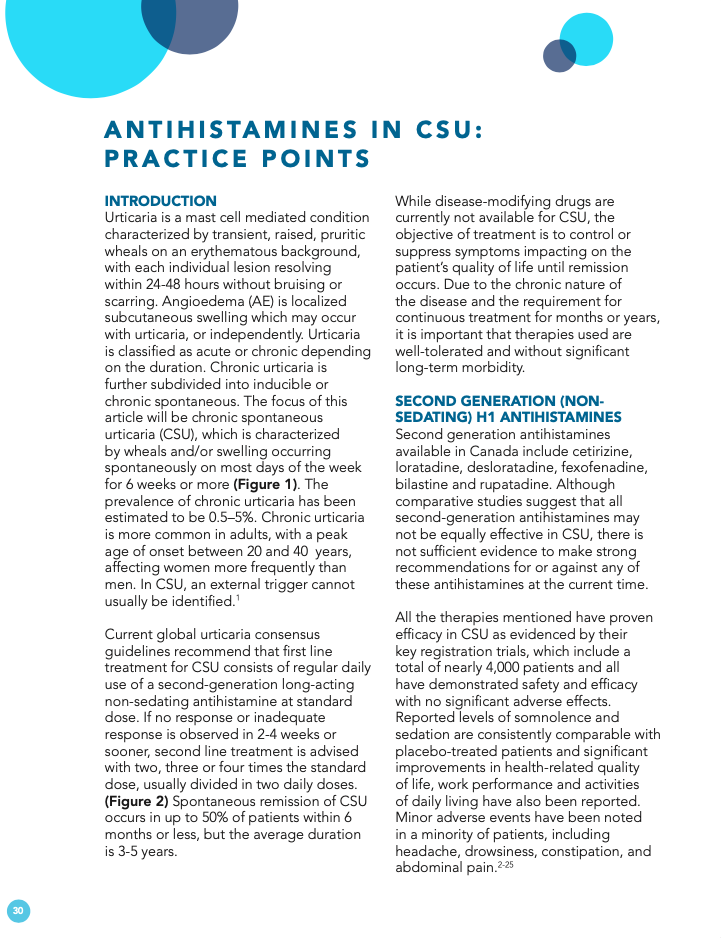Antihistamines in CSU: Practice Points
DOI:
https://doi.org/10.58931/cait.2021.1115Abstract
Urticaria is a mast cell mediated condition characterized by transient, raised, pruritic wheals on an erythematous background, with each individual lesion resolving within 24-48 hours without bruising or scarring. Angioedema (AE) is localized subcutaneous swelling which may occur with urticaria, or independently. Urticaria is classified as acute or chronic depending on the duration. Chronic urticaria is further subdivided into inducible or chronic spontaneous. The focus of this article will be chronic spontaneous urticaria (CSU), which is characterized by wheals and/or swelling occurring spontaneously on most days of the week for 6 weeks or more . The prevalence of chronic urticaria has been estimated to be 0.5–5%. Chronic urticaria is more common in adults, with a peak age of onset between 20 and 40 years, affecting women more frequently than men. In CSU, an external trigger cannot usually be identified.
References
Zuberbier T, Aberer W, Asero R, Abdul Latiff AH, Baker D, Ballmer-Weber, et al. The EAACI/GA²LEN/EDF/WAO guideline for the definition, classification, diagnosis and management of urticaria. Allergy. 2018 July;73(7): 1393-1414. doi:10.1111/all.13397
Augustin M, Ehrle S. Safety and efficacy of desloratadine in chronic idiopathic urticaria in clinical practice: an observational study of 9246 patients. J Eur Acad Dermatol. Venereol. 2009 Mar;23(3): 292-299. doi:10.1111/j.1468-3083.2008.03034.x
Breneman DL. Cetirizine versus hydroxyzine and placebo in chronic idiopathic urticaria. Ann Pharmacother. 1996 Oct;30(10): 1075-1079. doi:10.1177/106002809603001001
Finn AF, Kaplan AP, Fretwell R, et al. A double-blind, placebo-controlled trial of fexofenadine HCl in the treatment of chronic idiopathic urticaria. J Allergy Clin Immunol. 1999 Nov;104(5): 1071-1078. doi:10.1016/s0091-6749(99)70091-6
Goh CL, Wong WK, Lim J. Cetirizine vs placebo in chronic idiopathic urticaria–a double blind randomised cross-over study. Ann Acad Med Singap. 1991 May;20(3):328-30.
Grob JJ, Auquier P, Dreyfus I, et al. How to prescribe antihistamines for chronic idiopathic urticaria: desloratadine daily vs PRN and quality of life. Allergy. 2009 Mar;64(4):605-12.
Juhlin L, Arendt C. Treatment of chronic urticaria with cetirizine dihydrochloride a non-sedating antihistamine. Br J Dermatol. 1988 Jul;119(1):67-71. doi:10.1111/j.1365-2133.1988.tb07103.x
Juhlin L. Cetirizine in the treatment of chronic urticaria. Clin Ther. 1991 Jan-Feb;13(1):81-6.
Kalivas J, Breneman D, Tharp M, et al. Urticaria: clinical efficacy of cetirizine in comparison with hydroxyzine and placebo. J Allergy Clin Immunol. 1990 Dec;86(6 Pt 2):1014-8. doi: 10.1016/s0091-6749(05)80246-5.
Kaplan AP, Spector SL, Meeves S, et al. Once-daily fexofenadine treatment for chronic idiopathic urticaria: a multicenter, randomized, double-blind, placebo-controlled study. Ann Allergy Asthma Immunol. 2005 Jun;94(6):662-9. doi:10.1016/S1081-1206(10)61325-7
Kapp A, Pichler WJ. Levocetirizine is an effective treatment in patients suffering from chronic idiopathic urticaria: a randomized, double-blind, placebo-controlled, parallel, multicenter study. Int J Dermatol. 2006 Apr;45(4):469-74.
Kawashima M, Harada S. Efficacy and safety of fexofenadine HCl in Japanese patients with chronic idiopathic urticaria. Int Arch Allergy Immunol. 2001 Jan-Mar;124(1-3): 343–345.
Koti I, Weller K, Makris M, Tiligada E, Psaltopoulou T, Papageorgiou C, et al. Disease activity only moderately correlates with quality of life impairment in patients with chronic spontaneous urticaria. Dermatology. 2013;226(4):371-9. doi:10.1159/000351711
Kulthanan K, Gritiyarangasan P, Sitakalin C, Charuwichitratana S, Korkij W, Aunhachoke K, et al. Multicenter study of the efficacy and safety of fexofenadine 60 mg. twice daily in 108 Thai patients with chronic idiopathic urticaria. J Med Assoc Thai. 2001 Feb;84(2):153-9.
Monroe EW, Bernstein DI, Fox RW, Grabiec SV, Honsinger RW, Kalivas JT, et al. Relative efficacy and safety of loratadine, hydroxyzine, and placebo in chronic idiopathic urticaria. Arzneimittelforschung. 1992 Sept;42(9):1119-1121.

